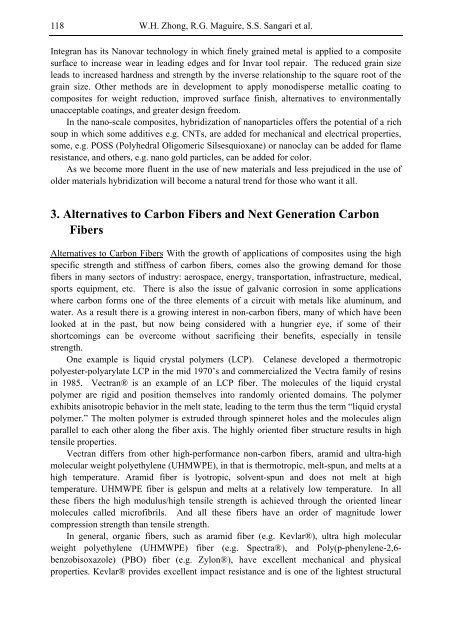Composite Materials Research Progress
Composite Materials Research Progress
Composite Materials Research Progress
You also want an ePaper? Increase the reach of your titles
YUMPU automatically turns print PDFs into web optimized ePapers that Google loves.
118<br />
W.H. Zhong, R.G. Maguire, S.S. Sangari et al.<br />
Integran has its Nanovar technology in which finely grained metal is applied to a composite<br />
surface to increase wear in leading edges and for Invar tool repair. The reduced grain size<br />
leads to increased hardness and strength by the inverse relationship to the square root of the<br />
grain size. Other methods are in development to apply monodisperse metallic coating to<br />
composites for weight reduction, improved surface finish, alternatives to environmentally<br />
unacceptable coatings, and greater design freedom.<br />
In the nano-scale composites, hybridization of nanoparticles offers the potential of a rich<br />
soup in which some additives e.g. CNTs, are added for mechanical and electrical properties,<br />
some, e.g. POSS (Polyhedral Oligomeric Silsesquioxane) or nanoclay can be added for flame<br />
resistance, and others, e.g. nano gold particles, can be added for color.<br />
As we become more fluent in the use of new materials and less prejudiced in the use of<br />
older materials hybridization will become a natural trend for those who want it all.<br />
3. Alternatives to Carbon Fibers and Next Generation Carbon<br />
Fibers<br />
Alternatives to Carbon Fibers With the growth of applications of composites using the high<br />
specific strength and stiffness of carbon fibers, comes also the growing demand for those<br />
fibers in many sectors of industry: aerospace, energy, transportation, infrastructure, medical,<br />
sports equipment, etc. There is also the issue of galvanic corrosion in some applications<br />
where carbon forms one of the three elements of a circuit with metals like aluminum, and<br />
water. As a result there is a growing interest in non-carbon fibers, many of which have been<br />
looked at in the past, but now being considered with a hungrier eye, if some of their<br />
shortcomings can be overcome without sacrificing their benefits, especially in tensile<br />
strength.<br />
One example is liquid crystal polymers (LCP). Celanese developed a thermotropic<br />
polyester-polyarylate LCP in the mid 1970’s and commercialized the Vectra family of resins<br />
in 1985. Vectran® is an example of an LCP fiber. The molecules of the liquid crystal<br />
polymer are rigid and position themselves into randomly oriented domains. The polymer<br />
exhibits anisotropic behavior in the melt state, leading to the term thus the term “liquid crystal<br />
polymer.” The molten polymer is extruded through spinneret holes and the molecules align<br />
parallel to each other along the fiber axis. The highly oriented fiber structure results in high<br />
tensile properties.<br />
Vectran differs from other high-performance non-carbon fibers, aramid and ultra-high<br />
molecular weight polyethylene (UHMWPE), in that is thermotropic, melt-spun, and melts at a<br />
high temperature. Aramid fiber is lyotropic, solvent-spun and does not melt at high<br />
temperature. UHMWPE fiber is gelspun and melts at a relatively low temperature. In all<br />
these fibers the high modulus/high tensile strength is achieved through the oriented linear<br />
molecules called microfibrils. And all these fibers have an order of magnitude lower<br />
compression strength than tensile strength.<br />
In general, organic fibers, such as aramid fiber (e.g. Kevlar®), ultra high molecular<br />
weight polyethylene (UHMWPE) fiber (e.g. Spectra®), and Poly(p-phenylene-2,6benzobisoxazole)<br />
(PBO) fiber (e.g. Zylon®), have excellent mechanical and physical<br />
properties. Kevlar® provides excellent impact resistance and is one of the lightest structural
















